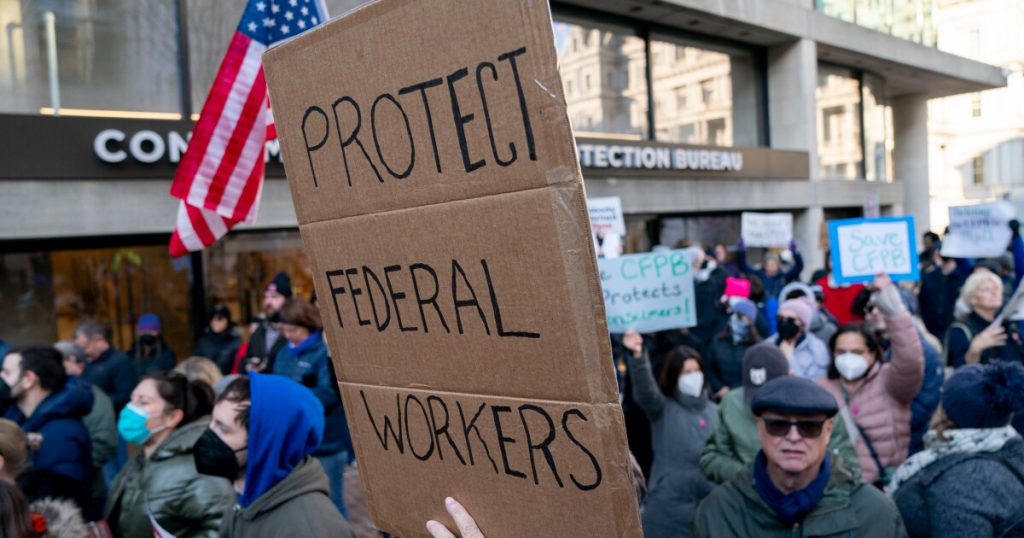Employees at the Consumer Financial Protection Bureau are bracing for mass layoffs now that Congress has slashed the agency’s budget in half and the Supreme Court gave the Trump administration the go-ahead to gut federal agencies.
Acting CFPB Director Russell Vought is expected to issue a reduction in force, or RIF, immediately after an appellate panel rules on whether to lift a lower court injunction that has prevented the agency from successfully instituting mass layoffs.
A three-judge panel of the U.S. Court of Appeals for the D.C. Circuit is expected to rule imminently on whether the Trump administration can issue a RIF, which could result in the firing of up to 1,300 employees at the beleaguered agency. The CFPB had 1,750 employees in February; several hundred have left the agency in the past few months, according to CFPB employees and union officials.
On Monday the Supreme Court
“The subject of a RIF could simply be addressed by following the Supreme Court’s ruling and engaging in a similar pattern to reduce the workforce of the CFPB,” said Kim Holzel, a partner at the law firm Goodwin. “I think they’ll use a blueprint created by the Supreme Court case to do that.”
This week, the CFPB’s leadership began cancelling the staff’s inactive PACER accounts, the system that provides online access to federal court records. Bureau officials also began mid-year performance reviews using a new performance management system, according to internal emails.
There is a slim chance that the D.C. Circuit panel, made up of two Trump appointees, sides with the National Treasury Employees Union, which
“Even if the D.C. Circuit did come back and say that the CFPB has to meet its mandate, [and] it has to be functioning, I don’t think that stops the administration from reducing the head count,” Holzel said.
A district court judge in February
The Dodd-Frank Act gave the CFPB’s director significant power over the agency. The law describes the CFPB’s specific functions and offices but did not specify a minimum number of employees.
“This is the death knell of the CFPB,” said Joe Lynyak, a partner at Dorsey & Whitney LLP. “There is a clear pathway for the CFPB to do a large reduction in force immediately.”
The NTEU has claimed that the CFPB did not follow proper procedures in firing staff, and that the Trump administration’s goal was to dismantle the agency, which cannot be done without an act of Congress. The CFPB enforces 18 different consumer protection laws that, before the 2010 creation of the agency, were spread across federal agencies.
Lynyak said the Supreme Court has given Trump “a great deal of deference.” In his second term, Trump has embraced the
“The Supreme Court has taken the position of the unitary executive being able to do whatever they want and the administration is figuring out how to get their way,” Lynyak added. “With the way the Supreme Court is acting in a very favorable manner, they’ve got a high probability of success.”
Adding to the Supreme Court wins for the Trump administration, Congress passed the
The bureau’s maximum funding is now roughly $445 million, according to industry sources. Last year, the CFPB requested $729.4 million in transfers from the Federal Reserve,
Moran said the reconciliation bill highlights the fact that existing funding and staffing levels are not set in stone.
“It means the agency has a statutory mandate now to reduce expenses, which presumably includes headcount, to some degree,” said Eamonn Moran, a partner at Holland & Knight. “It may not be 90%, but that’s a factor now that wasn’t in the mix before. It’s now law.”
Moran and others say the CFPB has already taken steps indicating they are confident in their ability to fire staff.
“Before the recent Supreme Court decisions permitting agency reductions in force and now, they seem to be fairly confident that they’re on the winning side of the D.C. Circuit,” Moran said.
Employees were ordered months ago to remove all their belongings from the CFPB’s headquarters, which was shuttered in February immediately after Vought was appointed. Most of the CFPB’s staff has been told to be “work ready,” though most are not working.
“Right now there’s a lot of people who are sitting at home doing nothing to get paid, so that’s not efficient,” Hozel said. “There is a cost and expense associated with laying people off and hiring people and then retraining people too. So I think even if there is an administration change and a complete swing of policy the other way, in four years, there is not going to be a pipeline of trained employees to accomplish their goals.”

